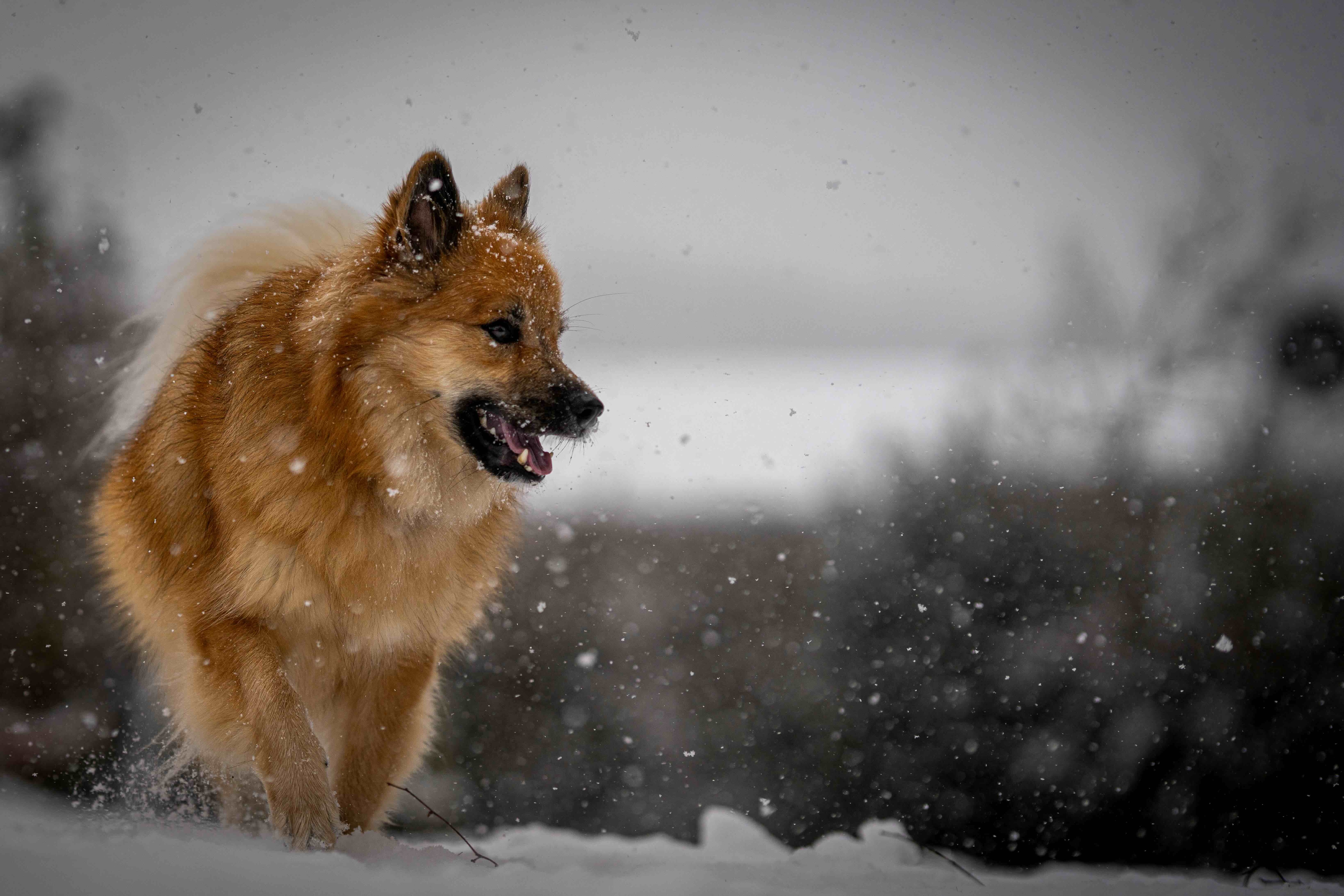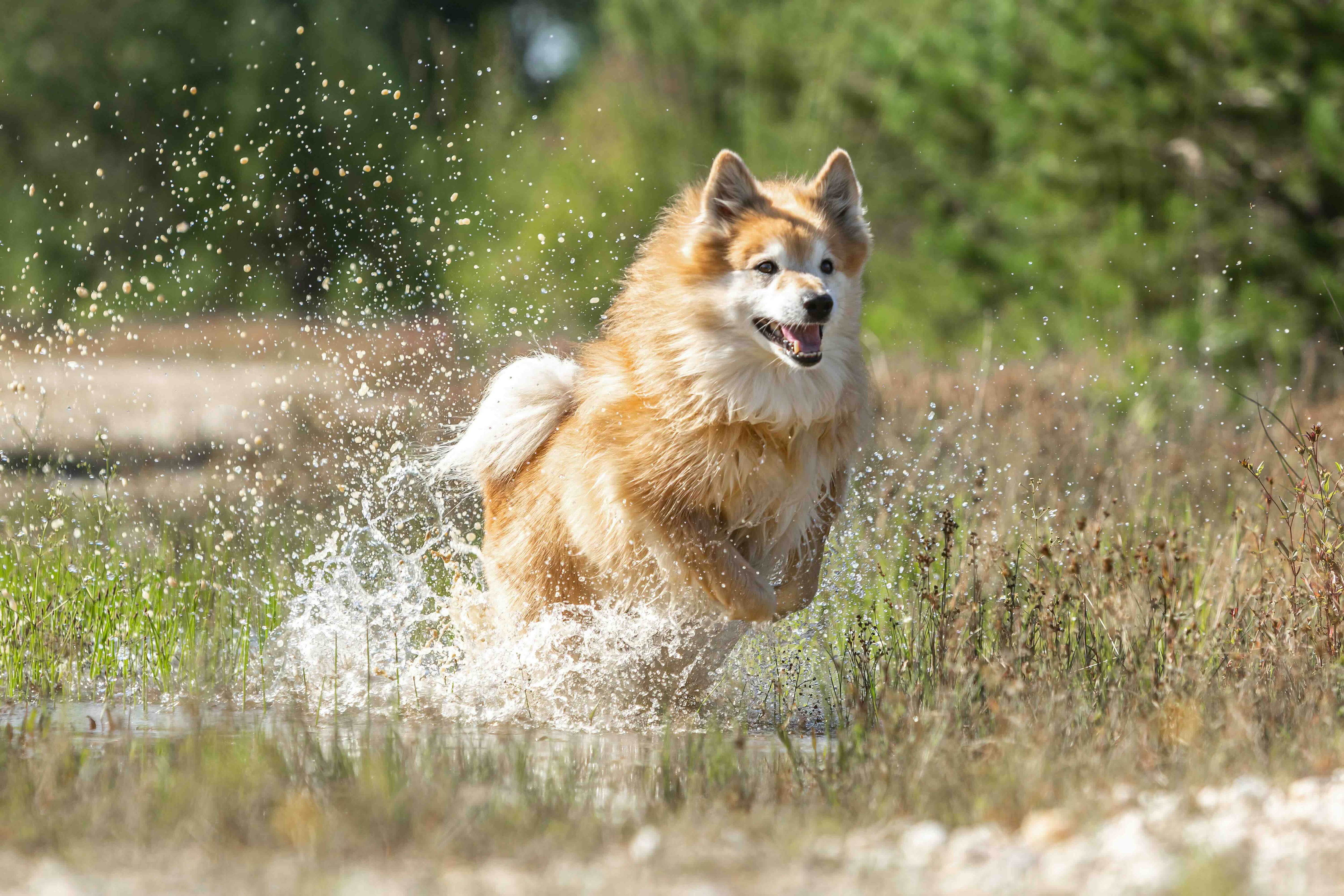Icelandic Sheepdog
Adobe Stock/Mikkel Bigandt
The Icelandic Sheepdog breed descends from dogs that Viking settlers brought to Iceland. According to the Icelandic Sheepdog Association of America (ISAA), the Icelandic Sheepdog is related to the Karelian Bear Dog and was historically used to herd horses, cattle, and sheep.
The Icelandic Sheepdog’s size is smaller than a typical herding breed, weighing 25–30 pounds and standing 16.5–18 inches at the shoulder. Because of their thick coat, pointed ears, and curled tail, the dogs are considered a Nordic Spitz breed and closely resemble a fox. The Icelandic Sheepdog is the only dog breed native to Iceland.
Caring for an Icelandic Sheepdog
Their affection and loyalty to their family members make the Icelandic Sheepdog a great family dog. They want nothing more than to be by their humans’ side, but they need an active household to be their happiest. Icelandic Sheepdogs have a high energy level, so they need activities, such as going on a run or herding animals on a farm, to keep them entertained.
Thanks to their intelligence and work ethic, Icelandic Sheepdogs pick up training cues quickly and want nothing more than to please their family members. However, it’s still important to begin training and socializing Icelandic Sheepdog puppies when they’re 8 weeks old—just like with any dog breed.
Their thick, double coat does shed a lot, so a weekly brushing is needed to minimize matting and reduce the amount of loose fur inside your home.
Icelandic Sheepdog Health Issues

Icelandic Sheepdogs typically live 12–14 years, the average lifespan for a medium-sized dog. They’re considered to be healthy dogs, but they may experience certain medical conditions at some point in their life.
Elbow Dysplasia
Elbow dysplasia is a term that encompasses several inherited orthopedic conditions that ultimately lead to degenerative joint disease (DJD) within the elbow. Icelandic Sheepdogs may have:
Any of these conditions can cause lameness and pain in the affected forelimb, especially after exercise.
Elbow dysplasia can occur in one or both elbows. X-rays or advanced imaging (CT scans) are the most common tests used to diagnose this condition.
Elbow dysplasia is treated through surgery, and the prognosis is generally good if surgery is done when the dog is young and the disease process is still in its early stages. Icelandic Sheepdogs with a history of elbow dysplasia should not be bred.
Hip Dysplasia
Hip dysplasia is an inherited orthopedic condition where the head of the femur doesn’t sit snugly in the hip joint. As a result, the femoral head (top of the thigh bone) tends to rub against the hip socket. Over time, there is bony remodeling of the hip joint that leads to arthritis in the dog.
Just as elbow dysplasia can develop in one or both elbows, hip dysplasia can develop in one or both hip joints. Some Icelandic Sheepdog puppies are born with congenital hip dysplasia (although this is rare); others develop it during their senior years. Symptoms include:
-
Lameness
-
Slowness to rise from lying down
-
Bunny-hopping gait when running
-
Reluctance to run, jump, or go up or down stairs
-
Holding the affected leg out to the side when sitting up
Treatment depends on severity. In some cases, hip dysplasia can be managed through supplements, medications, and reduced activity levels. In other cases, a dog may need to undergo surgery to correct the hip dysplasia.
Luxating Patella
Patellar luxation, another orthopedic condition, is when your dog’s kneecap moves (luxates) out of place, most often due to a shallow groove in the femur. There are varying degrees of patellar luxation, and the most severe cases require surgery.
A reputable Icelandic Sheepdog breeder will have their dogs evaluated for patellar luxation before breeding to make sure only those without this medical condition produce puppies.
Cataracts
A cataract is a cloudy lens within the eye. They can be small or large; the larger the cataract, the more significant the loss of vision.
Cataracts are usually hereditary, so breeders should not breed Icelandic Sheepdogs with a family history of the condition. Surgery to remove cataracts and restore eyesight is a treatment option for more severe cataracts.
Retinal Dysplasia
Retinal dysplasia is an inherited condition in which the retina (a light-sensitive layer of cells in the back of the eye) doesn’t develop properly. This condition can be diagnosed in young Icelandic Sheepdog puppies.
Sheepdogs with mild cases of retinal dysplasia may show no symptoms and not be affected long-term, while others may be completely blind. There is no treatment for this condition.
What To Feed an Icelandic Sheepdog

Icelandic Sheepdogs need to eat a high-quality dog food formulated for a medium-sized breed that meets the nutritional standards set by the Association of American Feed Control Officials (AAFCO). Talk to your veterinarian about choosing the best dog food for your pup—they can point you in the right direction.
How To Feed an Icelandic Sheepdog
Adult dogs should be fed twice daily, while Icelandic Sheepdog puppies do best eating three times daily to reduce the risk for hypoglycemia (low blood sugar).
Like all dogs, Icelandic Sheepdogs should always be fed a diet that matches their life stage:
-
Puppies need a puppy-formulated food
-
Adults need a dog food made for medium-sized breeds
-
Senior Icelandic Sheepdogs benefit from a senior-specific dog food to meet their unique needs as they age
No more than 10% of their daily diet should consist of dog treats.
How Much Should You Feed an Icelandic Sheepdog?
Dog food packaging provides guidance on how much to feed your dog, based on their ideal weight. But for the best advice, talk with your veterinarian to find out what your Icelandic Sheepdog needs, based on the health, lifestyle, and age of your dog.
There is no overarching recommendation for feeding amounts.
Nutritional Tips for Icelandic Sheepdogs
A healthy Icelandic Sheepdog eating an AAFCO-compliant dog food shouldn't need anything more, as their food is formulated to provide all the nutrients they need. However, there are situations that might prompt a veterinarian to recommend supplements for your dog.
For example, Icelandic Sheepdogs with joint issues, such as a patellar luxation or hip dysplasia, may benefit from a joint supplement and an omega-3 fatty acid supplement to reduce joint inflammation.
Talk with your veterinarian to find out if your Icelandic Sheepdog would benefit from a supplement.
Behavior and Training Tips for Icelandic Sheepdogs
Icelandic Sheepdog Personality and Temperament

While every dog is an individual with their own personality, the Icelandic Sheepdog temperament is known to be affectionate, curious, and friendly, according to the breed club. They are not known to be fearful or anxious, and these friendly dogs will “greet strangers as old friends,” according to the ISAA.
Social Icelandic Sheepdogs are typically good with children and pets, including other dogs and cats, when introduced properly.
Icelandic Sheepdog Behavior
The Icelandic Sheepdog’s herding history carries over to their behavior today. They are known to chase cars and neighborhood wildlife, so it’s important to supervise your dog and keep them within a fenced area or on a leash whenever they’re outside. Icelandic Sheepdogs can also bark a lot, as this was a form of communication when herding livestock.
These dogs do best in a home with active and outdoorsy pet parents as Icelandic Sheepdogs love being outside, and need exercise and mental stimulation to be content. Taking long walks and hiking are two of their favorite activities.
Icelandic Sheepdog Training
As affectionate and smart dogs, Icelandic Sheepdogs are considered easy to train. Always use positive reinforcement methods and keep sessions engaging: These dogs enjoy entertaining their loved ones and receiving rewards for good behavior. Leash training is especially important for Icelandic Sheepdogs.
Begin socializing your Icelandic Sheepdog puppy when they’re young, and talk to your vet about how to do so safely. Socialization gets your dog used to new people, animals, and situations so they grow into confident dogs.
Fun Activities for Icelandic Sheepdogs
Icelandic Sheepdog Grooming Guide

This breed has a dual-layer, weather-resistant coat that can be either short or long. There are many Icelandic Sheepdog colors, including gray, red, black, cream, chocolate, and combinations of these and other hues.
Icelandic Sheepdogs shed year-round, but more heavily in the spring and fall. Special attention needs to be paid to their coat during these times.
Skin Care
Icelandic Sheepdogs do well with a regular bath every month or two, but they don’t require special skin care. Contact your vet if you notice changes in your dog’s skin or if your dog seems itchier than normal.
Because this breed loves spending time outside, make sure your Icelandic Sheepdog is always on flea and tick preventative medication.
Coat Care
Brush your dog at least once a week to help with shedding and minimize matting. Icelandic Sheepdogs shed more heavily in the spring and fall, so you’ll need to increase brushing frequency during these seasons.
Due to their dense coat, Icelandic Sheepdogs are prone to matting. But a professional groomer won’t be needed as long as pet parents remove tangles regularly.
Eye Care
Because Icelandic Sheepdogs are predisposed to retinal dysplasia and cataracts, schedule an appointment with your veterinarian if you notice issues or changes in your dog’s eyes.
Ear Care
Due to their pointed ears, Icelandic Sheepdogs are less likely to have ear infections compared to floppy-eared dogs, such as the Basset Hound. However, it’s still recommended to clean an Icelandic Sheepdog’s ears with a routine ear cleaner, like Epi-Otic® Advanced, once a month and after bathing to keep the ears clear of wax and debris.
Considerations for Pet Parents
Icelandic Sheepdogs have a sweet temperament and are always ready to please their pet parents. They are highly intelligent and excel in training classes. They also require moderate exercise to keep their body and mind stimulated.
While Icelandic Sheepdogs may be happiest living on a farm or in a home that has a fenced yard due to their energy level, this breed is small enough to live comfortably in an apartment or condo as long as they get enough outside time. They need to be given jobs to do to keep them entertained during the day, such as participating in dog sports.
Their thick dual coats need to be brushed weekly to prevent matting and reduce shedding inside the home.
Icelandic Sheepdog FAQs
How much does an Icelandic Sheepdog cost in the US?
The average Icelandic Sheepdog price for a puppy is $1,200–$2,500.
Do Icelandic Sheepdogs make good pets?
Yes, Icelandic Sheepdogs have a loving temperament and are known to be easy to train. When socialized, they are well behaved around other pets and children.
Do Icelandic Sheepdogs bark a lot?
Yes, Icelandic Sheepdogs are known to bark a lot, thanks to their history as a herding dog. Positive reinforcement training can help quiet your dog.
